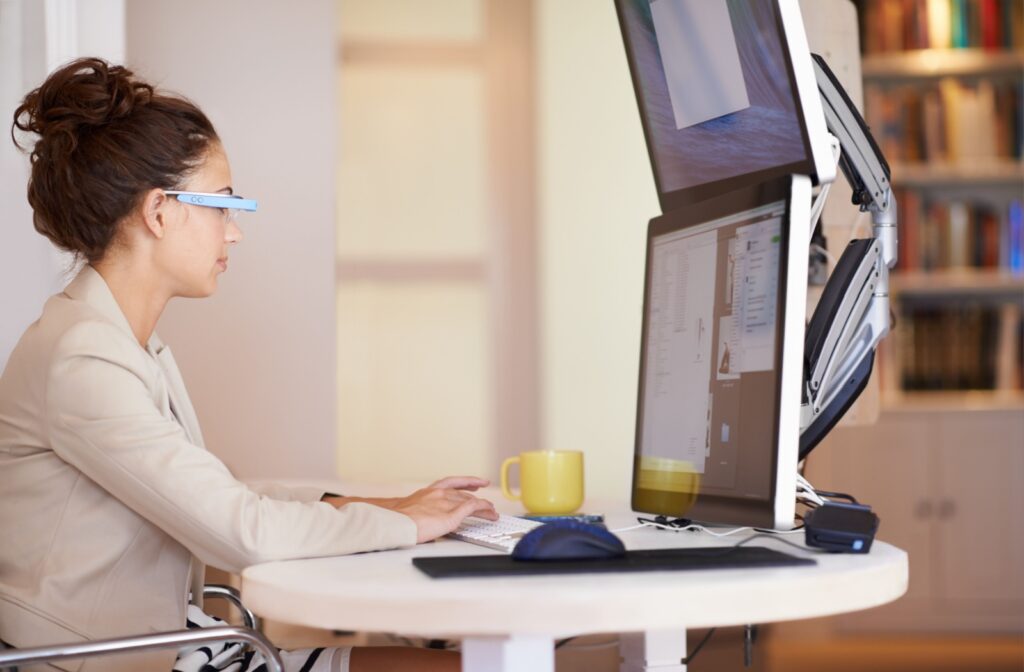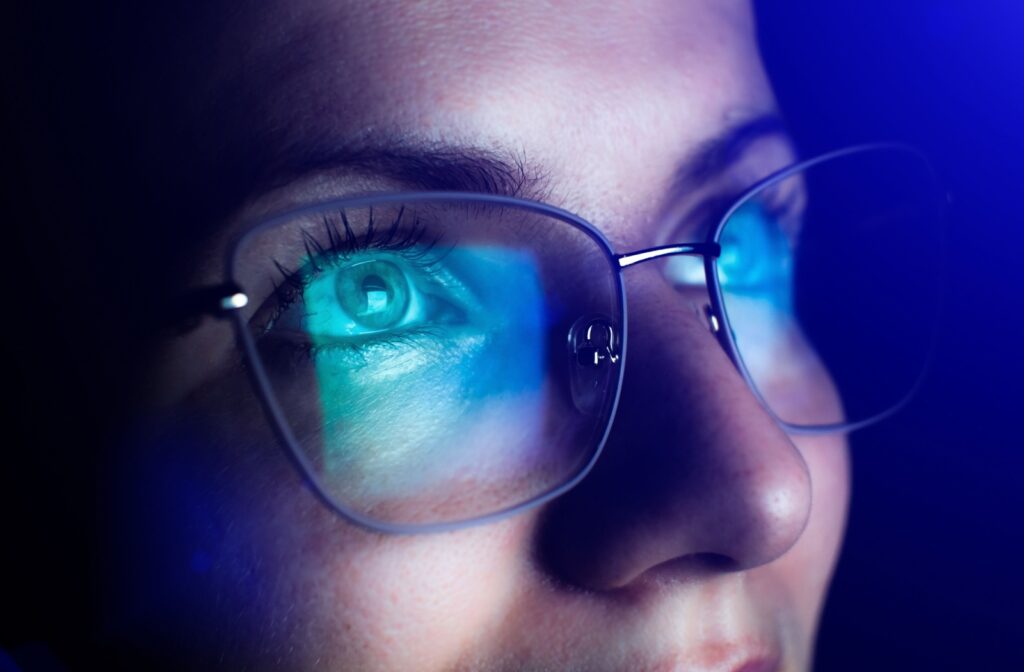The world of wellness is full of helpful tips, some of which work much better than others. Blue light glasses, for instance, are increasingly popular, especially as exposure to digital screens becomes more normal at work and even in our downtime.
On a technical note, you can wear blue light glasses anytime! But some lenses can have a slight yellow tint. If color accuracy is important in your day-to-day (perhaps you’re a graphic designer, artist, or photographer), this is something to consider.
Blue light glasses are great to wear when:
- Spending hours staring at digital screens
- Using digital screens during your night shift or in the evening
- Gaming late at night or binge-watching
Blue light glasses can help keep you comfortable by supporting your vision and keeping your sleep cycle on track.
A Closer Look at Blue Light
Blue light might sound like a buzzword, but it really does exist. It’s a high-energy, short-wavelength light found naturally in sunlight and emitted by digital devices like computers, smartphones, and tablets.
Exposure to natural blue light during the daytime is crucial for regulating your sleep-wake cycle, it helps keep you awake and alert. However, artificial blue light from screens requires extra caution, as prolonged exposure may lead to discomfort, fatigue, and disrupted sleep patterns.
Currently, no research suggests that exposure to blue light causes serious eye damage. However, people can experience discomfort from staring at screens for long periods, often known as digital eye strain.
What is Digital Eye Strain?
When your eyes overwork to focus on visually demanding tasks, they may become fatigued, leading to eye strain. Digital eye strain is more specific, as it materializes when you spend long hours staring at digital screens (think of your smartphone, laptop, tablet, etc.) without appropriate precautions.
Here’s how digital eye strain develops:
- Staring at screens reduces your blink rate, which can dry out your eyes.
- Glare and contrast on screens cause your eyes to refocus continually, leading to fatigue.
- Poor posture and positioning while using devices can add physical strain.
Common symptoms of digital eye strain include:
- Tired or dry eyes
- Blurry vision
- Headaches
- Difficulty focusing on tasks
- Neck and shoulder discomfort
If you’re someone who suffers from dry eyes, digital eye strain can aggravate the condition, worsening symptoms and adding to your overall discomfort. As our world becomes more digital, people are increasingly turning to potential solutions.
This is where blue light glasses can help—though not necessarily in the way you might think.
All About Blue Light Glasses
Blue light glasses have a special lens coating that filters out or blocks a portion of blue light that digital screens emit. The idea is that this filtering helps ease the side effects of working on digital devices, such as digital eye strain.
Unfortunately, they don’t quite deliver in that department. As of now, no evidence suggests that blue light glasses prevent digital eye strain. However, if having a blue light filter on your glasses encourages you to wear your prescription lenses, we’d consider that a win.
Look at this way: if you need corrective lenses but don’t wear prescription glasses or contacts, your eyes overwork themselves when focusing on visual tasks, leading to eye strain. Wearing the right glasses supports your eyes (with or without a blue light filter) so they don’t have to overcompensate when you’re reading, writing, or working on your computer.
Here’s what the research has shown us: blue light from digital screens can affect natural melatonin production in your body, disrupting your sleep pattern, and making it harder for your body to wind down at night.
When to Wear Blue Light Glasses
You might have noticed that older blue light glasses featured a slight yellow tint. These days, some blue light glasses are almost clear, making them more pleasant to wear.
Theoretically, you could wear blue light glasses anytime; however, they’re going to be most effective when they’re blocking blue light from a screen:
- A student or professional who spends long hours staring at a computer.
- If you’re working a night shift or using screens before bed.
- If you’re gaming or binge-watching your favorite show.
Blue light glasses do filter out blue light, which can disrupt your body’s natural sleep cycle, keeping you up at night. With these glasses, you can maintain solid melatonin levels while still correcting your vision, letting you get a good night’s rest, which indirectly supports your mental health.

Digital Eye Strain Management
It’s helpful to think of blue light glasses as a tool that can support your eyes and your natural sleep cycle, instead of a one-and-done solution to digital eye strain. Along with other practices, blue light glasses can help you manage screen-related discomfort:
Follow the 20-20-20 Rule
The 20-20-20 rule is a simple yet effective way to give your eyes regular breaks. Every 20 minutes, look at something 20 feet away for 20 seconds. This helps reduce strain from prolonged near-focus on a screen or any other visually demanding task.
If possible, take a 5–10 minute break every hour to step away from your devices. Use this time to stretch or focus on an activity that doesn’t involve screens.
Create a Comfortable Workspace
Poor posture and lighting can contribute to eye strain and overall discomfort.
- Avoid bright overhead lights or harsh glares in your workspace. Instead, use softer or diffused lighting.
- Lower the brightness of your screen to match the lighting in your environment.
- Enable “night mode” or “blue light filters” on your devices during evening hours.
- Place your screen about 20–26 inches away (at arm’s length) and slightly below eye level to promote proper posture and solid distance between you and your screen.
Hydrate Your Eyes
When your eyes focus on a visually demanding task, you tend to blink less. Every blink helps replenish the tear film, so blink frequently, and replenish your eyes with artificial tears for added moisture.
Keep Your Eyes Comfortable
Wearing blue light glasses can help keep your eyes comfortable, but they’re not a surefire way to prevent digital eye strain. Our tips above, along with routine eye exams, can help manage digital eye strain and support your vision and overall eye health.
Whether you’re due for a routine eye exam or interested in exploring custom lenses (like blue light filters) connect with Dr. Goldstone Foundation Valley. Book an appointment or stop by for a visit, and experience the beauty of comfortable vision.



